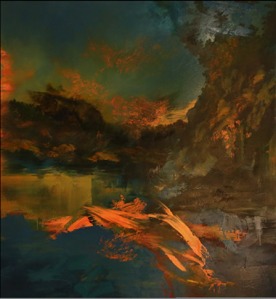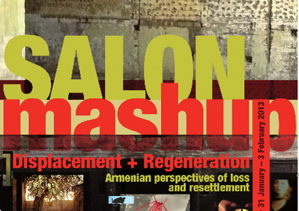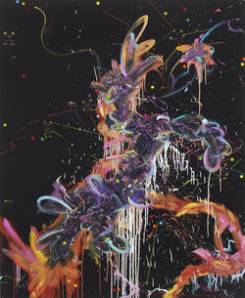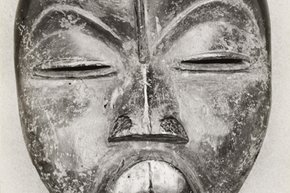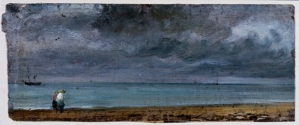The House of St Barnabas is a charity that works to help people affected by homelessness get into lasting employment. The charity was originally founded in 1846 by philanthropists Henry Munro and Roundel Palmer and has been striving to help London’s most disadvantaged citizens ever since. It is inevitably incongruous then that the building the charity works out of, and has been resident in, since 1862, should also function as an exclusive private members club but it seems to work on both counts. It was here, that I met artist Alan Rankle to discuss his inclusion in the club’s current exhibition ‘The Collective’, curated by Katie Heller featuring both emerging and established artists.
Originally built in 1679, the Georgian house sits discreetly on Soho Square, it is fabulous, a warren of corridors, gorgeous old furniture and beautifully proportioned rooms all brought to a sizzling vibrancy by fantastic contemporary art. It has a Rococo decorative scheme, lots of busy plaster work with ornate cornices and ceilings, and, all around the walls, small and huge plaster work frames created specifically for the display of art collections.
I first came across Rankle’s work in a very similar establishment, Lloyds Club, a private members club in the City, also with art curated by Heller and her colleagues at the curatorial collective Patch London within a Georgian house. At that time, I was struck by how Rankle’s work fitted with, and commented on, its environment, so, inevitably, he gets asked about this seeming connection to his art. Rankle’s view is that he feels comfortable working with these kinds of spaces and his work certainly seems to sit well within them.
The first work I saw at St Barnabas House was in the entrance hall; behind the reception is a large rectangular plaster frame that takes up most of the back wall to the staircase. The space was clearly created for a statement art piece and Rankle has reacted to that with ‘Untitled Painting VIII’ 2015. He explained his technique for creating this piece, it starts from images of Rankle’s own works layered in a photo-montage along with an anonymous eighteenth century painting and various random photographs made with his collaborator Sarah Lloyd, the resulting images are then used as preparatory studies for developing the paintings. This reflects on the artist’s early interest in art conservation and the phenomenon of pentimenti, the idea of how as you peel back time you peel back layers. So you see in the painting an essence of old masters, references to landscapes, hunting and still life works but also something much more fluid than that as the present peeks in; the colours are vibrant and alive, and an almost violent, painterly approach daubs across the canvas serving to disrupt any pretence that Rankle has created the painting in anything other than the contemporary present.
In quite a contrast, on the opposite wall, but in no less grand scale, Rankle’s ‘Untitled Painting IV’ 2015, reflects on his interest in landscape and abstraction and features an iconic vista of a Norwegian Fjord. This painting is much calmer, less frenetic; there is a deeper sense of Rankle’s homage to landscape, and for me, reminiscent of the pastoral peace of Claude Lorraine. However, Rankle interrupts this notion with his journeys during the 1970’s, his passion for the emergence of pop art and the anti –attitudes of Warhol and Pollock, the painter speaks for himself, the graffitiesque scribblings in bright red at the bottom of the canvas do not allow the viewer a sonorous Arcadia to swim in but create a question about art and the presence of the artist.
Moving into the main drawing room upstairs, I was very much struck by ‘Untitled Painting XI (Herne)’, 2015. It’s a painting that stops you and asks you to look, a stag emerging from a seeming sea of blood red, immediately took me to thoughts of mortality, all the more so, because of the unknowing innocence on the face of the stag and the implications of imminent death from the pervasive presence of red paint. I was somewhat surprised to discover then in discussion with Rankle, that from his perspective, what he was reaching for was actually that sense of layering again, contemporary and ancient and what comes in between, what the stag is apparently disappearing so serenely into, or possibly emerging from, is not blood and death but layers of art history.
I really like Rankle’s work and it does fit incredibly well with these Georgian spaces, although that should not be all that surprising really. We may consider that contemporary art has outrun the kind of staid, imitative painting these kinds of spaces were built to house but actually there are many interconnections. The cold white cube of the contemporary gallery space, devised to provide a neutral, minimalist backdrop in order to elevate artwork for contemplative communion can also serve to unsheathe art of context. The spaces here were intended to, and do, invite collaboration with the house, its inhabitants and ideals. I can imagine that the drawing room may well originally have contained a didactic display of paintings that connected to the aims of the charity in its larger spaces and held portraits of benefactors in smaller frames. Now, we find reflections of the charity’s current aims, nurturing artists by providing a display space that results in a dazzling display of art which brings the house to life while continuing to raise the multitude of issues contemporary artists such as Rankle seek to explore.
